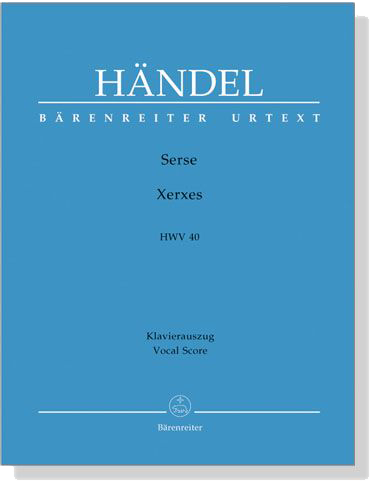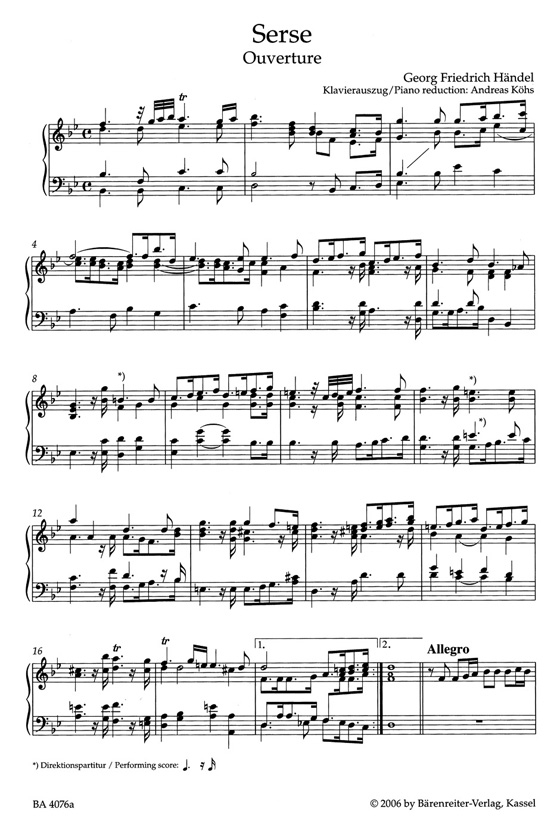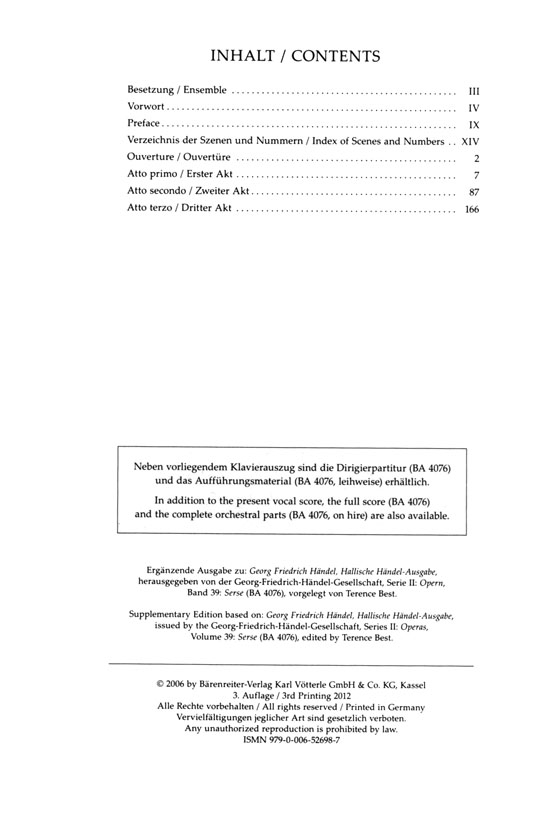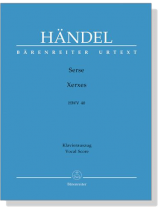Handel【Serse Xerxes , HWV 40】Klavierauszug , Vocal Score






Handel【Serse Xerxes , HWV 40】Klavierauszug , Vocal Score
-
巴洛克德國作曲家韓德爾歌劇「Serse - Xerxes,Opera in three acts , HWV 40」Klavierauszug , Vocal Score。
- 庫存狀況: 尚有庫存
- 出版社: Bärenreiter
- 原文書名: Serse - Xerxes HWV 40 opera in three acts
- 作者: George Frideric Handel
- 編訂者: Best, Terence
- 總書頁: 231
- 商品編號: 9790006526987
- ISBN: 9790006526987
NT 1,348
NT 1,348
未稅: NT 1,348
簡介
【簡介】
Handel started writing “ Serse ” on 26 December 1737 and completed the third act on 6 February 1738. The première took place on 15 April of the same year at the King’s Theatre in the Haymarket. Four performances followed, after which the work was not heard again until 1924.
The opera focuses on the Persian king Serse , who, rather than serving as a military commander or statesman, appears at the centre of a highly complex love story. Handel provided an admixture of buffo elements (the antics of the servant Elviro , the stupidity of the soldier Ariodate ) to the standard ingredients of opera seria , such as the broadly declaimed woes of Serse , Romilda , Arsamene , and Amastre .
This interweaving of seemingly incompatible stylistic resources arose in Naples and can already be found in the 17th century librettos that served as the principal sources of Handel’s Serse .
Though unsuccessful at the time, today “ Serse ” is prized precisely for its comic undertones and is regularly seen on stage.
Our new Urtext vocal score is based on the volume edited by Terence Best for the “Halle Handel Edition” (series II/volume 39).
• Straightforward performance-oriented vocal score based on the Urtext of the “Halle Handel Edition”
•Original Italian text with singing German translation
Handel started writing “ Serse ” on 26 December 1737 and completed the third act on 6 February 1738. The première took place on 15 April of the same year at the King’s Theatre in the Haymarket. Four performances followed, after which the work was not heard again until 1924.
The opera focuses on the Persian king Serse , who, rather than serving as a military commander or statesman, appears at the centre of a highly complex love story. Handel provided an admixture of buffo elements (the antics of the servant Elviro , the stupidity of the soldier Ariodate ) to the standard ingredients of opera seria , such as the broadly declaimed woes of Serse , Romilda , Arsamene , and Amastre .
This interweaving of seemingly incompatible stylistic resources arose in Naples and can already be found in the 17th century librettos that served as the principal sources of Handel’s Serse .
Though unsuccessful at the time, today “ Serse ” is prized precisely for its comic undertones and is regularly seen on stage.
Our new Urtext vocal score is based on the volume edited by Terence Best for the “Halle Handel Edition” (series II/volume 39).
• Straightforward performance-oriented vocal score based on the Urtext of the “Halle Handel Edition”
•Original Italian text with singing German translation
目錄
【簡介】
Handel started writing “ Serse ” on 26 December 1737 and completed the third act on 6 February 1738. The première took place on 15 April of the same year at the King’s Theatre in the Haymarket. Four performances followed, after which the work was not heard again until 1924.
The opera focuses on the Persian king Serse , who, rather than serving as a military commander or statesman, appears at the centre of a highly complex love story. Handel provided an admixture of buffo elements (the antics of the servant Elviro , the stupidity of the soldier Ariodate ) to the standard ingredients of opera seria , such as the broadly declaimed woes of Serse , Romilda , Arsamene , and Amastre .
This interweaving of seemingly incompatible stylistic resources arose in Naples and can already be found in the 17th century librettos that served as the principal sources of Handel’s Serse .
Though unsuccessful at the time, today “ Serse ” is prized precisely for its comic undertones and is regularly seen on stage.
Our new Urtext vocal score is based on the volume edited by Terence Best for the “Halle Handel Edition” (series II/volume 39).
• Straightforward performance-oriented vocal score based on the Urtext of the “Halle Handel Edition”
•Original Italian text with singing German translation
Handel started writing “ Serse ” on 26 December 1737 and completed the third act on 6 February 1738. The première took place on 15 April of the same year at the King’s Theatre in the Haymarket. Four performances followed, after which the work was not heard again until 1924.
The opera focuses on the Persian king Serse , who, rather than serving as a military commander or statesman, appears at the centre of a highly complex love story. Handel provided an admixture of buffo elements (the antics of the servant Elviro , the stupidity of the soldier Ariodate ) to the standard ingredients of opera seria , such as the broadly declaimed woes of Serse , Romilda , Arsamene , and Amastre .
This interweaving of seemingly incompatible stylistic resources arose in Naples and can already be found in the 17th century librettos that served as the principal sources of Handel’s Serse .
Though unsuccessful at the time, today “ Serse ” is prized precisely for its comic undertones and is regularly seen on stage.
Our new Urtext vocal score is based on the volume edited by Terence Best for the “Halle Handel Edition” (series II/volume 39).
• Straightforward performance-oriented vocal score based on the Urtext of the “Halle Handel Edition”
•Original Italian text with singing German translation
詳細規格
| 書籍資訊 | |
| 記譜法 | 五線譜(一般) |
| 原文語言 | 義大利文 |
| 特徵 | 西洋古典 |
| 適用對象 | 高級 |
| 古典作曲家 | Handel, G.F 韓德爾 |
| 聲樂 | 歌劇 |
| 時期與風格 | 巴洛克樂派 |
| 裝訂 | 平裝 |
| 形式 | 譜 |
| 外型尺寸 | 約A4尺寸 |

